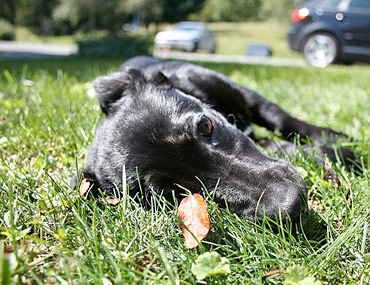Overview
Your dog’s spine is an amazing work of natural engineering! Every movement of his body is dependent upon the structural alignment and strength of the spinal cord and the vertebrae and discs that protect it. Each vertebra in your dog’s spine is separated from the next by an intervertebral disc. Every time your dog runs, jumps, or plays, these fluid-filled discs act as shock absorbers by helping to displace the weight load on the spine.
Your dog’s spine is divided into three regions: cervical, thoracic, and lumbar. The cervical spine supports your dog’s neck and shoulders. The thoracic spine supports the chest and abdominal region and the lumbar spine supports your dog’s lower back and hindquarters.
Canine intervertebral disc disease (IVDD) occurs when a disc in your dog’s spine is ruptured or herniated, leaking its contents and causing severe inflammation and pain for your best friend. When this happens, the disc is no longer able to act as a shock absorber or help with the weight load put on the spine. IVDD has serious side effects for your pooch, and the symptoms differ depending on where along the spine the problem disc is located.
The most common cause of IVDD is conformation and age, Over time, the discs in your dogs back lose their flexibility, making them more susceptible to injury. Severe injury is another common cause of intervertebral disc disease.
Chondrodysplatic breeds—those with short legs and long backs—are most commonly affected by IVDD; these include:
 Symptoms
Symptoms
Intervertebral disc disease can be very painful and should be attended to immediately. If left untreated, serious secondary issues including permanent paralysis can result.
Symptoms will vary depending on which part of your dog’s spine is impacted, but can include:
- Stiffness of the neck
- Back pain
- Crying when handled or picked up
- Shivering
- Reluctance to run or play
- Inability to walk or a peculiar gait
- Paralysis
- Paresis (partial loss of movement or weakness)
Diagnosis
Your veterinarian will perform a thorough physical exam and take a complete medical history of your pet. Additionally, they will most likely want to perform additional tests.
These may include:
- A complete neurological exam
- X-rays of the spine
- Myelography, an injection of dye into the spinal cord
- Referral to a specialist for MRI or CT scans
Treatment
Treatment will depend on the severity of the disc disease and what is best for your dog, specifically. It can include medications and strict crate/cage rest. Medications will help reduce the swelling of the disc and relax your dog’s muscles. Surgery is also an option, in some situations. As your dog heals, your veterinarian may recommend physical therapy, as well. Keeping your dog’s weight under control and watching her carefully is vital to her recovery and also will help to limit any future problems.
If you have any questions or concerns, you should always visit or call your veterinarian – they are your best resource to ensure the health and well-being of your pets.
